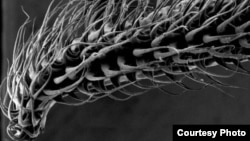A new study on how bats use their tongues to collect nectar could lead to a new generation of medical devices.
The study, published in the Proceedings of the National Academy of Sciences, showed that the bat Glossophaga soricina is able to rapidly engorge numerous hair-like structures on the tip of its tongue with blood to form a perfect mop for nectar. By extending the hair-like structures, both the surface area and length of the tongue are enhanced, allowing maximum efficiency for nectar gathering.
The findings could be combined with informaion about how hummingbirds and bees morph their tongues to extract nectar and lead to new medical technologies, say scientists at Brown University.
“Together these three systems could serve as valuable models for the development of miniature surgical robots that are flexible, can change length and have dynamic surface configurations,” the authors of the study wrote.
The whole process for the bat to transform its tongue takes only an eighth of a second, the study said, adding that the hovering process over a nectar filled flower uses a lot of calories so the bat must be able to extract the calories in the quickest way possible to be worthwhile.
“Typically, hydraulic structures in nature tend to be slow like the tube-feet in starfish,” said lead author Cally Harper, a graduate student in the Department of Ecology and Evolutionary Biology at Brown University in a statement. “But these bat tongues are extremely rapid because the vascular system that erects the hair-like papillae is embedded within a muscular hydrostat, which is a fancy term for muscular, constant-volume structures like tongues, elephant trunks and squid tentacles.”
That the bat had hair-like structures on its tongue was not new to scientists, but previously they thought they worked only like the limp strings on a mop.
The authors of the study do not know if other nectar-feeding bats have similar tongues, but speculate that other creatures like the honey possum might also have a similar way to gather food quickly.
The study, published in the Proceedings of the National Academy of Sciences, showed that the bat Glossophaga soricina is able to rapidly engorge numerous hair-like structures on the tip of its tongue with blood to form a perfect mop for nectar. By extending the hair-like structures, both the surface area and length of the tongue are enhanced, allowing maximum efficiency for nectar gathering.
The findings could be combined with informaion about how hummingbirds and bees morph their tongues to extract nectar and lead to new medical technologies, say scientists at Brown University.
“Together these three systems could serve as valuable models for the development of miniature surgical robots that are flexible, can change length and have dynamic surface configurations,” the authors of the study wrote.
The whole process for the bat to transform its tongue takes only an eighth of a second, the study said, adding that the hovering process over a nectar filled flower uses a lot of calories so the bat must be able to extract the calories in the quickest way possible to be worthwhile.
“Typically, hydraulic structures in nature tend to be slow like the tube-feet in starfish,” said lead author Cally Harper, a graduate student in the Department of Ecology and Evolutionary Biology at Brown University in a statement. “But these bat tongues are extremely rapid because the vascular system that erects the hair-like papillae is embedded within a muscular hydrostat, which is a fancy term for muscular, constant-volume structures like tongues, elephant trunks and squid tentacles.”
That the bat had hair-like structures on its tongue was not new to scientists, but previously they thought they worked only like the limp strings on a mop.
The authors of the study do not know if other nectar-feeding bats have similar tongues, but speculate that other creatures like the honey possum might also have a similar way to gather food quickly.










